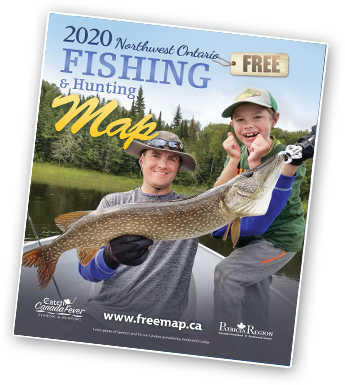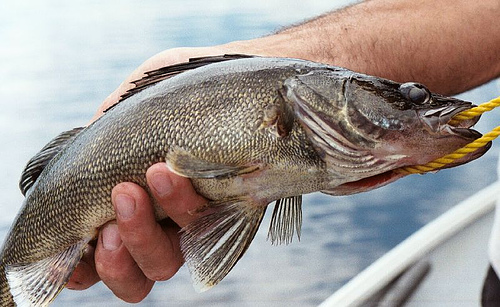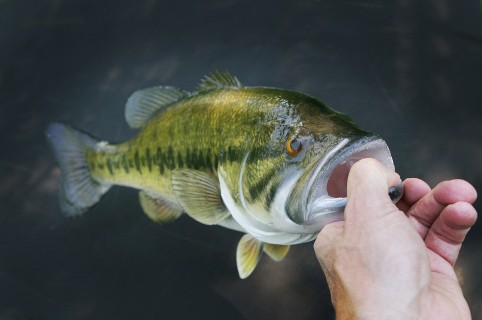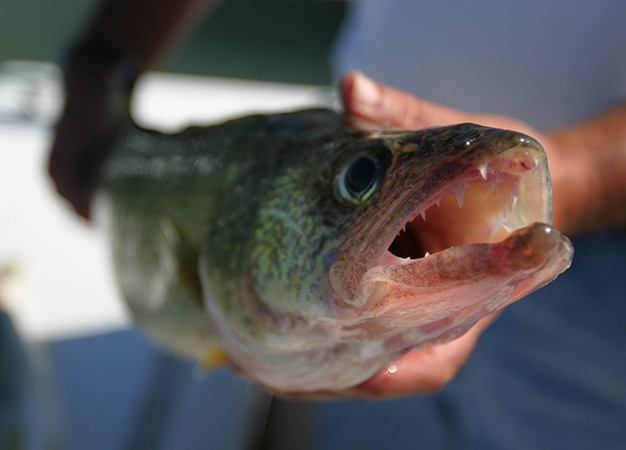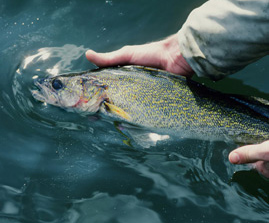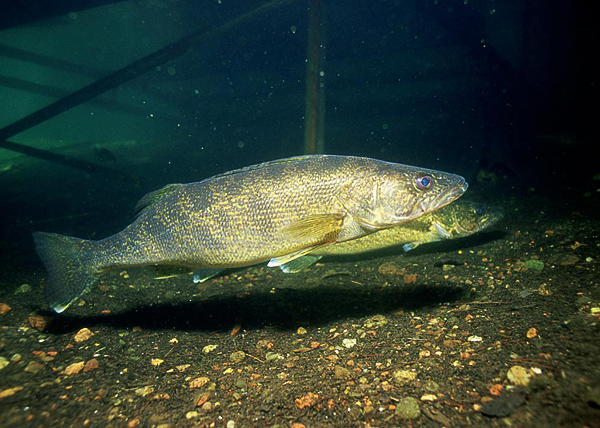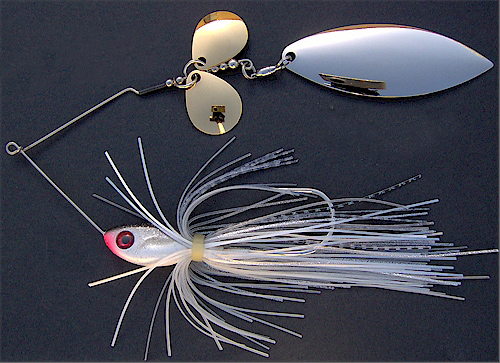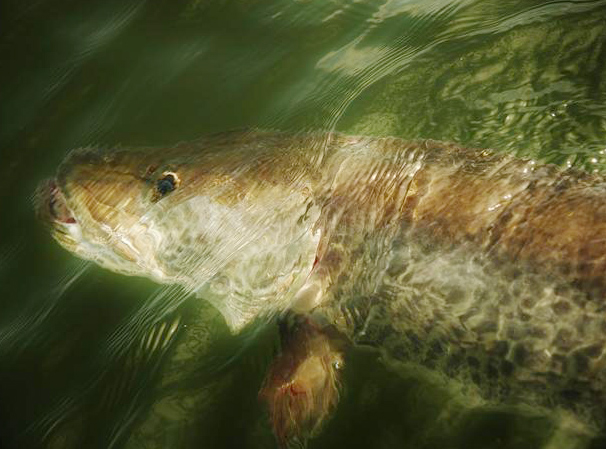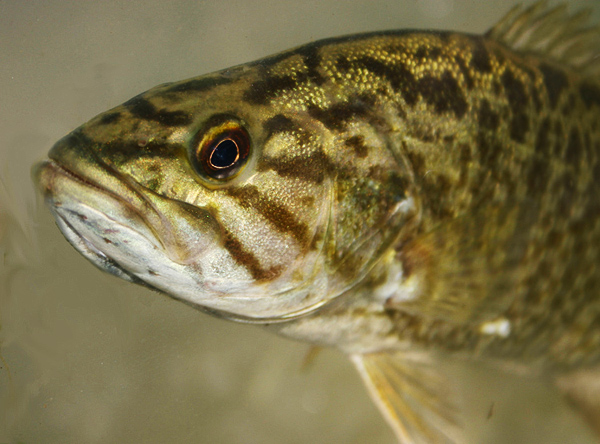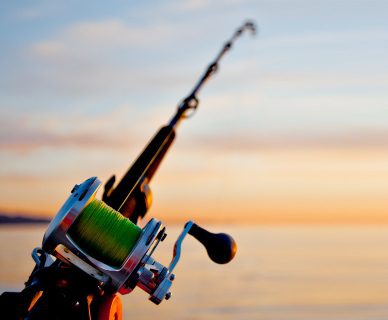By Gord Ellis
Worms are the most versatile bait in the walleye angler’s arsenal. Crawlers work in the cold water of spring and fall, and during the hottest days of summer. They catch walleye in rivers and lakes. These fish like the smell, look, and feel of a worm. Yet many anglers, weaned on television fishing shows and endless super-lure infomercials, consider live-worm fishing passe, even vaguely dirty. To each their own, but if there aren’t a couple of dozen nightcrawlers in your cooler when you head out walleye fishing at night, you’re at a disadvantage. Here are a few worm tricks to increase your catch in Northwest Ontario.
Jigs
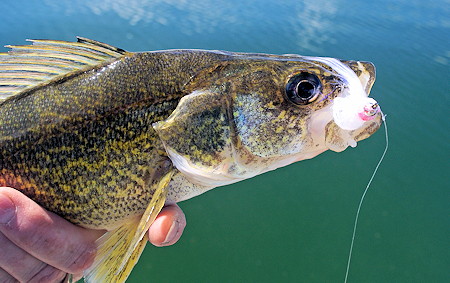 Worms wiggle and squirm pretty well, which is one reason walleye seem to like them, but when used to tip a jig, a worm imitates a dancing minnow, a flitting crayfish, or a swimming nymph. On Lake Erie, nightcrawlers have been used for years as sweeteners on weight-forward spinner jigs like the Erie-Dearie. The crawler is threaded nose first on to the hook and slid on to the shaft, allowing just a section of the tail to trail enticingly behind the lure. This same technique can be used on a bare jig head.
Worms wiggle and squirm pretty well, which is one reason walleye seem to like them, but when used to tip a jig, a worm imitates a dancing minnow, a flitting crayfish, or a swimming nymph. On Lake Erie, nightcrawlers have been used for years as sweeteners on weight-forward spinner jigs like the Erie-Dearie. The crawler is threaded nose first on to the hook and slid on to the shaft, allowing just a section of the tail to trail enticingly behind the lure. This same technique can be used on a bare jig head.
Split-tailing is a great trick to add even more movement to a jig. Impale a full nightcrawler directly in the middle with the hook. Leave the two ends of the worm to hang down enticingly, creating a double dose of wiggle. When split-tailing a jig, the shank of the hook is primarily free, so you can still add a small rubber grub for colour, scent, or bulk.
If you want to slow the fall of your jig, a useful tactic in shallow water, use a commercial worm blower to inflate the tail section of the worm. If the crawler has been threaded onto the hook, the tail will float up. When split-tailing, you can inflate both the head and tail of the worm, which allows for an even slower fall.
Rigging
A worm, a No. 6 short-shank bait-holder hook, and a 3/8-ounce slip-sinker have probably provided more walleye shore lunches than any other technique in North America. It’s the meat-and-potatoes walleye rig for pro and novice alike. When rigging a worm, hook it through the tip of the nose and then turn the hook barb out of its side. A rigged worm hooked off-centre will spin and look less appealing to fish. It can also wreak havoc on your leader.
Many anglers use floating jig heads to keep their rigged crawlers off bottom, out of mud and weed, ans visible in water with poor clarity but there are times when walleye don’t want to see extra hardware near a worm. When fish are finicky, a more natural way to float a crawler off bottom is to again inflate the front portion of it. If you want the worm to suspend horizontally, give it a touch of air in the back portion, as well. The more air you pump into the worm, the higher it will float off bottom. Don’t over-inflate it, though, or it will end up looking like an over-cooked sausage.
If you plan to still-fish with a slip-sinker rig, or drift a crawler along bottom in current, you might want to hook the bait through the center. This allows both ends of the worm to wriggle naturally. As in split-tailing, hook the crawler dead center once, twice at most. This method of hooking is also the best to use when fishing a worm under a float.
For use around weeds or snags, you can Texas-rig a live worm. It will be a little trickier to set up than a rubber worm, but the payoff is more hits. I hook the worm through the nose, push the barb out the bottom, and re-bury the hook dead center in the bait. Since live worms are softer, and we must assume tastier, than rubber, there’s no need to have the hook point exposed. Bury it in the worm, but when you feel a bite, make sure you strike hard enough to move the hook.
Catching walleye during a mayfly hatch is one of the biggest challenges an angler faces. One trick that works well is to cut a crawler in to quarters, hook one of them on a No. 8 short-shank hook, and then inflate it with a blower. This makes a reasonably convincing mayfly-nymph imitation. Work a small piece of worm slowly along weed flats or sand bays and wait for a school of walleye on the feed to show up. They’ll like the looks of this bait.
Spinner rigs
The classic walleye spinnerbait rig is a worm harness made with an Indiana blade, coloured beads, and three hooks tied in tandem. Generally, a whole nightcrawler is used on this harness. The front hook should be placed dead center in the worm’s snout. The other two hooks are buried in the skin along the full length of the worm. Walleye tend to nip at the tail of a whole crawler, hence the three hooks. A trick that many trollers use is to replace the single hooks with No. 6 or 8 trebles. You’ll hook more fish with them, especially if you normally fish with the rod in a holder, thereby missing some strikes.
Traditional French-style spinners, such as the Mepps Aglia, Blue Fox, and Double Loon, are effective walleye lures, especially when worked in current. They almost always benefit from a worm sweetening. Use half a crawler on each hook point of the spinner. Leave a couple of short pieces of worm trailing on the hook for added movement. Another trick I’ve seen used in eastern Canada is to add a single trailer hook on a 2-inch leader to a traditional spinner. A worm is threaded on the trailer hook. This set-up is especially good when trolled.
Crankbaits
One nearly forgotten trick is to tip the bottom hook of a wobbling plug with a worm. I first saw this technique used in the mid-1980s on Lac Des Mille Lacs in northwestern Ontario. In those days, the lure of choice was a Flatfish, yellow with red dots or a skunk pattern. The worm was braided onto the bottom treble of the lure and both were trolled slowly along bottom. One modification is to replace the lure’s bottom treble with a snelled single No.6 short-shank hook. A worm threaded onto this hook dangles enticingly below the wriggling lure. In addition to traditional wobbling plugs, minnow-shaped crankbaits also work well with worms.
If you haven’t tried walleye fishing with worms, or haven’t been that successful with them in the past, try some of the techniques in this article. My experience has been that the intersection of a healthy walleye and fat crawler almost always leads to a tight line. And tight lines mean happy walleye anglers.


